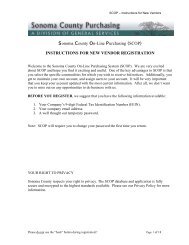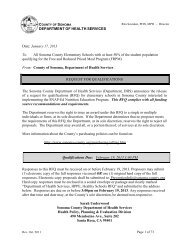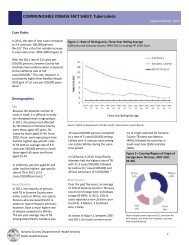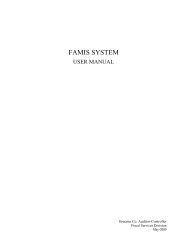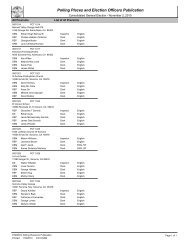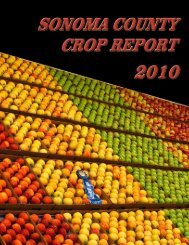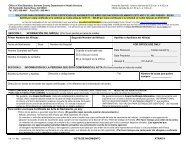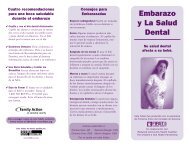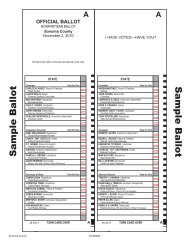Application Packet: Class B Cottage Food Operation - Sonoma County
Application Packet: Class B Cottage Food Operation - Sonoma County
Application Packet: Class B Cottage Food Operation - Sonoma County
Create successful ePaper yourself
Turn your PDF publications into a flip-book with our unique Google optimized e-Paper software.
COUNTY OF SONOMA DEPARTMENT OF HEALTH SERVICES<br />
ENVIRONMENTAL HEALTH & SAFETY<br />
625 5 TH Street<br />
Santa Rosa, CA 95404<br />
(707) 565-6565 / (707) 565-6525<br />
CLASS B<br />
COTTAGE FOOD OPERATION
COUNTY OF SONOMA DEPARTMENT OF HEALTH SERVICES<br />
ENVIRONMENTAL HEALTH & SAFETY<br />
625 5th Street ● Santa Rosa, CA 95404<br />
(707) 565-6565 ● FAX (707) 565-6525 ● http://www.sonoma-county.org/health/services/foodcottage.asp<br />
COTTAGE FOOD OPERATIONS<br />
On September 21, 2012, Governor Brown signed the California Homemade <strong>Food</strong> Act into law. This law amends the<br />
California Health and Safety Code (H&S Code) to create a new category of food operations, which unlike retail food<br />
facilities, can operate from a home kitchen. The <strong>Sonoma</strong> <strong>County</strong> Department of Health Services, Environmental Health<br />
and Safety Section will begin accepting applications for <strong>Cottage</strong> <strong>Food</strong> <strong>Operation</strong>s (CFOs) on January 1, 2013. The<br />
application packet will help guide you in submitting the necessary information to obtain a registration or permit.<br />
There are two classifications of CFOs: <strong>Class</strong> A and <strong>Class</strong> B. CFOs are required to obtain an annual registration or<br />
annual permit to operate. CFOs may sell directly and indirectly to the public, depending on their operational classification.<br />
<strong>Class</strong> A CFOs may sell cottage foods directly from their residence, certified farmers' markets, bake sales, and community<br />
events. <strong>Class</strong> A operations are required to complete a ‘<strong>Class</strong> A <strong>Cottage</strong> <strong>Food</strong> <strong>Operation</strong> Self-Certification Checklist’ and<br />
applicable accompanying attachments to obtain an annual registration.<br />
<strong>Class</strong> B CFOs are required to complete a ‘<strong>Class</strong> B <strong>Cottage</strong> <strong>Food</strong> <strong>Operation</strong> Supplemental <strong>Application</strong>’ and accompanying<br />
attachments to obtain an annual permit, and will be inspected annually. In addition to direct sales from the private<br />
residence, <strong>Class</strong> B operations are permitted to sell cottage foods indirectly from local shops, restaurants and other third<br />
party sales.<br />
Additionally, persons involved with preparing or packaging cottage food products must complete a <strong>Food</strong> Processor<br />
Course administered by the California Department of Public Health (CDPH) within three months of obtaining a registration<br />
or permit.<br />
While CFOs may operate from a private residence, they may be required to meet certain zoning and planning criteria,<br />
which can include issues such as parking, noise, traffic control, density, as well as other standards. Contact your local<br />
city planning department or <strong>Sonoma</strong> <strong>County</strong> Permit and Resource Management at 565-1900 for specific zoning<br />
requirements as related to your CFO.<br />
The California Department of Public Health has established a list of currently approved cottage food products that meet<br />
the definition as non-potentially hazardous. Additional foods may be added and removed through a 30-day review<br />
process. The list of currently approved cottage food products includes the following:<br />
• Baked goods without cream, custard or meat fillings (bread, churros, cookies, pastries, tortillas, etc.)<br />
• Candy, including chocolate covered nuts and dried fruit<br />
• Dried fruit and pasta<br />
• Dry baking mixes, granolas, cereals, and trail mixes<br />
• Fruit pies, fruit empanadas, and fruit tamales<br />
• Honey, jams, jellies and fruit butters<br />
• Nut mixes, nut butters and popcorn<br />
• Vinegar and mustards<br />
• Roasted coffee and dried tea<br />
• Waffle cones and pizelles<br />
In order to obtain a registration/permit, please complete the application and attachments and submit with your payment.<br />
Your application and attachments will be reviewed for compliance with the California Health & Safety Code. Please note:<br />
<strong>Class</strong> B CFOs are subject to inspection of their home kitchen prior to issuance of a permit. You can obtain additional<br />
information by contacting Environmental Health & Safety at (707) 565-6565, by visiting our office at 625 5 th Street, Santa<br />
Rosa or by visiting our website at: http://www.sonoma-county.org/health/services/food.asp
COUNTY OF SONOMA DEPARTMENT OF HEALTH SERVICES<br />
ENVIRONMENTAL HEALTH & SAFETY<br />
625 5th Street ● Santa Rosa, CA 95404<br />
(707) 565-6565 ● FAX (707) 565-6525 ● http://www.sonoma-county.org/health/services/foodcottage.asp<br />
APPLICATION FOR CLASS B COTTAGE FOOD OPERATION PERMIT<br />
A <strong>Cottage</strong> <strong>Food</strong> <strong>Operation</strong> allows nonpotentially hazardous food, such as baked goods, jams, jellies, preserves, fruit<br />
butters, dry herbs, dry blends or dry tea blends, to be produced in the kitchen of a person’s primary domestic residence<br />
within <strong>Sonoma</strong> <strong>County</strong>.<br />
NAME OF COTTAGE FOOD OPERATION<br />
PHONE (INCLUDE AREA CODE)<br />
OWNER NAME(S)<br />
CHECK APPROPRIATE BOX<br />
SEPTIC SYSTEM<br />
PUBLIC SEWER<br />
ADDRESS OF DOMESTIC HOME KITCHEN<br />
CHECK APPROPRIATE BOX<br />
PRIVATE WELL<br />
PUBLIC WATER<br />
CITY STATE ZIP<br />
MAILING ADDRESS<br />
EMAIL ADDRESS<br />
CITY STATE ZIP<br />
NAME OF CARDHOLDER<br />
<strong>Food</strong> Processor Card Information<br />
ID NUMBER<br />
Direct Sales<br />
Type of Sales<br />
Indirect Sales<br />
Owner’s Statement<br />
I (we) understand that a permit is issued upon investigation of the above named <strong>Cottage</strong> <strong>Food</strong> <strong>Operation</strong> when it<br />
is found to be in substantial compliance with applicable state law and county code. Fees are not prorated. The<br />
permit is valid for twelve months and shall expire at the end of this time period. If you wish to obtain a new permit,<br />
you must submit a new application, associated documents, payment of fees determined by the Board of<br />
Supervisors and submittal of a new application for permit. The permit may be suspended or revoked for good<br />
cause. The permit is not transferable upon change of ownership and is valid only for the location and type of<br />
cottage food product(s) indicated.<br />
I (we) agree to operate in compliance with all applicable statutes, orders, quarantines, rules or regulations<br />
prescribed by state law; a state officer or department, or the Public Health Officer for <strong>Sonoma</strong> <strong>County</strong>. Pursuant to<br />
the California Public Records Act, <strong>Cottage</strong> <strong>Food</strong> <strong>Operation</strong> <strong>Application</strong> information is a public document and must<br />
be released upon request.<br />
Proposed Start Date _____________________________<br />
Fee Enclosed $____________________________<br />
Print name(s) _________________________________ Signature(s) ________________________________Date___________<br />
Vet Exempt Yes No Have you ever had a CFO permit with <strong>Sonoma</strong> <strong>County</strong>? Yes No<br />
For Office Use only<br />
<strong>Class</strong> B CFO Permit: PE#__________ ID# _________________________ District__________ EHS Approval____________ Date___________<br />
DD214 Rec’d<br />
Amount Rec’d $____________ [ ] Cash [ ] Check [ ] Credit Card Trans# _________________<br />
Date rec’d ______________ By ___________
COUNTY OF SONOMA DEPARTMENT OF HEALTH SERVICES<br />
ENVIRONMENTAL HEALTH & SAFETY<br />
625 5th Street ● Santa Rosa, CA 95404<br />
(707) 565-6565 ● FAX (707) 565-6525 ● http://www.sonoma-county.org/health/services/foodcottage.asp<br />
CLASS B COTTAGE FOOD OPERATION<br />
SUPPLEMENTAL APPLICATION<br />
NAME OF COTTAGE FOOD OPERATION (CFO)_____________________________________<br />
NAME OF OWNER_____________________________________________________________<br />
DATE_________________<br />
PHONE________________<br />
CFO PHYSICAL ADDRESS_______________________________________________________________________________<br />
CFO MAILING ADDRESS________________________________________________________________________________<br />
EMAIL ADDRESS______________________________________________________________________________________<br />
<strong>Cottage</strong> <strong>Food</strong> Products (Please check the items you will prepare and offer.)<br />
Baked Goods (may not contain cream, custard or meat<br />
fillings), including (check all that apply to your operation)<br />
Breads Biscuits Churros<br />
Cookies Pastries Tortillas<br />
Other baked goods _________________________<br />
Candy, such as brittle and toffee<br />
Chocolate-covered nonperishable foods, such as nuts<br />
and dried fruit<br />
Dried Fruit<br />
Dried pasta<br />
Dried baking mixes<br />
Granola, cereals, and trail mixes<br />
Fruit pies, fruit empanadas, and fruit tamales<br />
Herb Blends and dried mole paste<br />
Honey and sweet sorghum syrup<br />
Jams, jellies, preserves and fruit butter that comply with<br />
standard described in Part 150 of Title 21 of the Code of<br />
Federal Regulations (These should be fruit products to<br />
assure that they are not potentially hazardous.)<br />
Nut mixes and nut butters<br />
Popcorn<br />
Vinegar and mustard<br />
Roasted coffee and dried tea<br />
Waffle cones and pizzelles<br />
The following requirements are outlined in the <strong>Cottage</strong> <strong>Food</strong> <strong>Operation</strong>s (CFO) regulations and are minimum standards of<br />
health and safety for the preparation of approved cottage foods in the home.<br />
Facility Requirements, Floor Plan and Equipment List—Attachment 1 YES NO<br />
The CFO is located in a private residence where the CFO operator currently resides.<br />
CFO food preparation will take place in the private kitchen within that home.<br />
Sketch of floor plan and list of utensils for food and kitchen areas provided (Attachment 1).<br />
Restroom to be used with CFO available (Attachment 1).<br />
Handwashing and warewashing facilities to be used with CFO available (Attachment 1).<br />
Employee and Training Requirements YES NO<br />
Have all persons preparing or packaging CFO products completed the CDPH food processor course?<br />
If YES, copies of certificates are attached.<br />
If NO, complete course within three months of CFO registration.<br />
Does the CFO have more than 1 employee? (Immediate family or household members are not included.)<br />
Water Supply, Sewage Disposal, Solid Waste Disposal & Zoning—Attachment 2 YES NO<br />
Is your water source a private well?<br />
If YES, have you completed testing for Total and Fecal Coliform bacteria, nitrate and nitrite? Attach test results.<br />
Is your water source a public water system or community services district?<br />
If YES, what is the name of the public water system or district?<br />
If your residence has a septic system, documentation of septic system clearance by the <strong>County</strong> of <strong>Sonoma</strong>,<br />
Permit and Resource Management Department (PRMD) is required. Documentation of PRMD clearance<br />
provided. (Attachment 2).<br />
Information regarding trash disposal provided (Attachment 2).<br />
Do you have any documentation regarding local zoning approval (<strong>Class</strong> B CFO only) (Attachment 2)?
<strong>Food</strong> Preparation Requirements YES NO<br />
Handwashing to be conducted immediately prior to handling foods and after engaging in any activity that<br />
contaminates hands, such as after using the toilet, coughing, sneezing, eating or smoking .<br />
Warm water, pump soap and single use paper towels are available for handwashing.<br />
All food ingredients used in the CFO products are from an approved source, and are safe and wholesome.<br />
Kitchen equipment and utensils used to produce CFO products shall be clean and sanitized prior to use.<br />
Location(s) of direct sale cottage food products provided (Attachment 3).<br />
Location(s) of indirect sale cottage food products provided (Attachment 3).<br />
Sales Plan—Attachment 3 YES NO<br />
<strong>Food</strong> Preparation/Handling Steps and Ingredients—Attachment 4 YES NO<br />
<strong>Food</strong> preparation/handling steps and list of ingredient of each CFO product provided.<br />
Labeling and Packaging—Attachment 5 YES NO<br />
All CFO products are labeled in compliance with the Federal <strong>Food</strong>, Drug and Cosmetic Act.<br />
The label also includes:<br />
The words “Made in a Home Kitchen” in 12-point type<br />
Common name of product or a descriptive name<br />
Name, city and zip code of the CFO<br />
Permit number and <strong>County</strong> of <strong>Sonoma</strong> (permit issuing authority)<br />
Ingredient list in descending order of weight<br />
Net quantity in English units (pounds) and metric units (grams)<br />
Declaration of food allergens, such as milk, eggs, fish, etc.<br />
Label legible and in English<br />
If nutrient content claim or health claim made, nutrition fact panel provided<br />
A sample label for each cottage food product is provided.<br />
Description of packaging and process of packaging to be used for each CFO product provided.<br />
Permissible Sales Requirements YES NO<br />
CFO products will be sold via direct sales.<br />
CFO products will be sold via indirect sales.<br />
Gross sales of CFO products will be less than:<br />
$35,000 for 2013<br />
$45,000 for 2014<br />
$50,000 for 2015 and beyond<br />
<strong>Operation</strong>al Requirements<br />
1. No cottage food preparation, packaging, or handling may occur within the home kitchen concurrent with any other<br />
domestic activities, such as family meal preparation, dishwashing, clothes washing or ironing, kitchen cleaning, or<br />
guest entertainment.<br />
2. No infants, small children, or pets may be in the home kitchen during preparation, packaging or handling of any<br />
cottage food products.<br />
3. Kitchen equipment and utensils used to produce cottage food products shall be clean and maintained in a good<br />
state of repair.<br />
4. All food contact surfaces, equipment, and utensils used for the preparation, packaging, or handling of any cottage<br />
food products shall be washed, rinsed and sanitized before each use.<br />
5. All food preparation, and food and equipment storage areas shall be maintained free of rodents and<br />
insects.<br />
6. Smoking shall be prohibited in the portion of a private home used for the preparation, packaging, storage, or<br />
handling of cottage food products and related ingredients or equipment, or both, while cottage food are being<br />
prepared, packaged, stored, or handled.<br />
I (we) agree to grant to the <strong>County</strong> of <strong>Sonoma</strong>, DHS, EHS the right to enter, during normal business hours or at other<br />
reasonable times, the permitted CFO area of the private residence for the purpose of inspection, including the collection of<br />
food samples.<br />
______________________________________ ___________________________________ ________________<br />
Print name(s) of <strong>Cottage</strong> <strong>Food</strong> Operator(s) Signature of <strong>Cottage</strong> <strong>Food</strong> Operator(s) Date
COTTAGE FOOD OPERATION (CFO)<br />
FACILITY, FLOOR AND EQUIPMENT PLAN<br />
ATTACHMENT 1<br />
The CFO application must include a floor plan showing all of the following:<br />
• Preparation equipment<br />
• <strong>Food</strong> contact work surfaces<br />
• Warewashing equipment<br />
• Restroom facility<br />
• Handwashing<br />
• Storage areas<br />
• Refrigeration equipment<br />
Sketch<br />
List of Equipment/Utensils<br />
______________________________________________________________________________<br />
______________________________________________________________________________<br />
______________________________________________________________________________<br />
______________________________________________________________________________<br />
______________________________________________________________________________<br />
______________________________________________________________________________<br />
______________________________________________________________________________<br />
______________________________________________________________________________<br />
______________________________________________________________________________<br />
______________________________________________________________________________
CLASS B<br />
COTTAGE FOOD OPERATION (CFO)<br />
WATER SUPPLY, SEWAGE DISPOSAL, SOLID WASTE DISPOSAL & ZONING<br />
ATTACHMENT 2<br />
Water Supply<br />
If your potable water source is from a private well, you will need to have the water tested by a<br />
state certified lab. The water sample must be absent of Total and Fecal Coliform bacteria. The<br />
water sample must have no more than 45 mg/L of Nitrate (as NO3). Submit a copy of the lab<br />
results. The water sample must have no more than 1.0 mg/L of Nitrite (as nitrogen).<br />
____________________________________________________________________________<br />
______________________________________________________________________________<br />
Sewage Disposal – Public Sewer System<br />
1. If your residence is connected to a public sewer system, provide the name of the public sewer<br />
agency:_________________________________________________________________<br />
Sewage Disposal – Septic System<br />
<strong>Class</strong> B CFO: Owner of residence to provide documentation of septic system clearance by the<br />
<strong>County</strong> of <strong>Sonoma</strong>, Permit and Resource Management Department (PRMD):<br />
______________________________________________________________________________<br />
______________________________________________________________________________<br />
______________________________________________________________________________<br />
Solid Waste Disposal<br />
Provide the name of the solid waste company that picks up your trash.<br />
______________________________________________________________________________<br />
______________________________________________________________________________<br />
______________________________________________________________________________<br />
Zoning<br />
Provide any documentation you have received from your local city or <strong>County</strong> of <strong>Sonoma</strong><br />
planning department regarding your CFO.<br />
______________________________________________________________________________<br />
______________________________________________________________________________<br />
______________________________________________________________________________
CLASS B<br />
COTTAGE FOOD OPERATION (CFO)<br />
SALES PLAN<br />
ATTACHMENT 3<br />
Sales Plan<br />
List the name of the business and address where the cottage food product(s) will be sold.<br />
Direct Sale: List the name of the business and address where ‘Direct Sale’ of cottage food<br />
products will take place.<br />
‘Direct Sale’ means a transaction between a cottage food operator and a consumer, where the<br />
consumer purchases the cottage food product directly from the cottage food operator. Direct<br />
sales include, but are not limited to, sale from the location of the cottage food operation,<br />
transactions at community events, bake sales, farm stands, Certified Farmers’ Markets and<br />
other locations provided the transaction occur in-person between the consumer and the cottage<br />
food operator.<br />
______________________________________________________________________________<br />
______________________________________________________________________________<br />
______________________________________________________________________________<br />
______________________________________________________________________________<br />
______________________________________________________________________________<br />
______________________________________________________________________________<br />
______________________________________________________________________________<br />
______________________________________________________________________________<br />
CFO operators who sell or give away food at a Certified Farmer’s Market or at a community<br />
event are required to obtain a temporary food facility permit from Environmental Health &<br />
Safety. If you are participating in a Certified Farmer’s Market or Community Event, please<br />
specify which:<br />
□ Certified Farmer’s Market □ Community Event □ Both<br />
Indirect Sale: List the name of the business and address where the ‘Indirect Sale’ of cottage food<br />
products will take place.<br />
‘Indirect Sale’ means a transaction between the cottage food operator, a third party retailer, and<br />
a consumer. The consumer purchases the cottage food product(s) from a third party retailer<br />
that holds a valid permit issued by the Environmental Health & Safety. Indirect sales include,<br />
but are not limited to, sales made in retail shops or retail food facilities where food may be<br />
immediately consumed on the premises.<br />
______________________________________________________________________________<br />
______________________________________________________________________________<br />
______________________________________________________________________________<br />
______________________________________________________________________________<br />
______________________________________________________________________________<br />
______________________________________________________________________________<br />
______________________________________________________________________________<br />
______________________________________________________________________________<br />
______________________________________________________________________________<br />
______________________________________________________________________________<br />
______________________________________________________________________________
CLASS B<br />
COTTAGE FOOD OPERATION (CFO)<br />
FOOD PREPARATION/HANDLING STEPS AND INGREDIENTS<br />
ATTACHMENT 4<br />
<strong>Food</strong> Preparation/Handling Steps and Ingredients<br />
Submit food preparation/handling steps with a list of all ingredients used to manufacture the<br />
cottage food product(s), submitting separate information for each individual cottage food product<br />
indicated on your application. Note: All ingredients shall be from an approved source.<br />
Example: Chocolate Chip Cookies<br />
Ingredients:<br />
butter<br />
white sugar<br />
brown sugar<br />
eggs<br />
vanilla extract<br />
white cookie mix<br />
baking soda<br />
hot water<br />
salt<br />
semisweet chocolate chips<br />
walnuts<br />
Preparation/Handling Steps:<br />
1. Cream together the butter, white sugar, and brown sugar until smooth.<br />
2. Beat in the eggs one at a time, then stir in the vanilla.<br />
3. Dissolve the baking soda in hot water. Add to batter along with salt.<br />
4. Stir in cookie mix, chocolate chips, and walnuts. Drop in large spoonfuls onto ungreased<br />
baking pans.<br />
5. Bake for 10 minutes in the preheated oven or until edges are browned.
CLASS B<br />
COTTAGE FOOD OPERATION (CFO)<br />
LABELING AND PACKAGING<br />
ATTACHMENT 5<br />
Labeling<br />
<strong>Cottage</strong> food products are required to be labeled in accordance with specific state and federal<br />
labeling regulations. The following list of labeling requirements is intended to assist CFOs in<br />
complying with basic labeling laws and regulations. Complete federal labeling requirements<br />
may be found in the Federal <strong>Food</strong>, Drug, and Cosmetic Act available at 21 U.S.C. Sec. 343 et<br />
seq. and 21 CFR Part 101.<br />
Packaged, processed food labels usually have two distinct areas: the principal display panel<br />
(also known as the primary display panel) and the information panel. The principal display<br />
panel information is part of the label the consumer will see first and is usually located on the<br />
front of the package. This panel lists the product name and net quantity of contents.<br />
The information panel is usually located to the immediate right of the principle display panel,<br />
and contains the nutrition facts statement. Computer generated labels affixed to cottage food<br />
products may list all required information on the principle display panel, provided that the<br />
information is displayed in a size and manner that will allow the information to be read by the<br />
average consumer.<br />
In addition, whenever a cottage food product is served without packaging or labeling in a<br />
permitted retail food facility or is used as an ingredient in the preparation of a food in a retail<br />
food facility, the retail customer must be notified that the food product or the ingredient in the<br />
food was processed in a CFO home kitchen.<br />
Copies of labels for each cottage food product you are proposing to manufacture must be<br />
included with your application.<br />
Labels shall include:<br />
1. Home kitchen identification. The words “Made in a Home Kitchen” in 12-point type must<br />
appear on the principal display panel.<br />
2. Common or descriptive name. The common or descriptive name of the CFO food<br />
product must be located on the principal display panel.<br />
3. CFO identification. The name, city, and zip code of the CFO operation which produced<br />
the cottage food product must be included on the label. If the CFO is not listed in a<br />
current telephone directory, then a street address must also be included on the label. (A<br />
contact phone number or email address is optional, but may be helpful for contact in<br />
case a consumer wishes to contact the CFO.)<br />
4. Registration or permit number. The label must include the registration or permit number<br />
of the <strong>Class</strong> A or <strong>Class</strong> B CFO which produced the cottage food product. <strong>Class</strong> B CFOs<br />
must indicate their <strong>County</strong> of <strong>Sonoma</strong> health permit number on their label.<br />
5. Ingredients. The label must include the ingredients of the cottage food product in<br />
descending order of predominance by weight, if the product contains two or more<br />
ingredients.
Labeling (continued)<br />
6. Net quantity. The net quantity (count, weight, or volume) of the food product in both<br />
English (pound) units and metric units (grams).<br />
7. Allergens. Declaration on the label in plain language if the food contains any of the<br />
major food allergens, such as milk, eggs, fish, shellfish, tree nuts, wheat, peanuts, and<br />
soybeans. There are two approved methods prescribed by federal law for declaring the<br />
food sources of allergens in packaged foods:<br />
a) in a separate statement immediately following or adjacent to the ingredient list, or<br />
b) within the ingredient list<br />
8. English language. The label must be legible and in English (accurately translated<br />
information in another language is optional).<br />
Examples of <strong>Class</strong> B Label:<br />
Peanut Toffee<br />
The Toffee Company<br />
Santa Rosa, 95407<br />
Permit Number: PR0002345<br />
Permitting Authority: <strong>County</strong> of<br />
<strong>Sonoma</strong>, Department of Health<br />
Services, Environmental Health &<br />
Safety Section<br />
Ingredients: Butter (milk, salt), cream,<br />
peanuts, sugar, eggs, salt.<br />
Contains: Peanuts, eggs<br />
Net weight: 6 ounces (170.098g)<br />
MADE IN A HOME KITCHEN<br />
9. Nutrient content claim. The use of the following eleven terms are considered nutrient<br />
content claims (nutritional value of a food): free, low, reduced, fewer, high, less, more,<br />
lean, extra lean, good source, and light. The Federal <strong>Food</strong> and Drug Administration has<br />
set conditions for the use of these terms. For example, the term ‘sodium free’ means<br />
that the food contains less than 5 milligrams of sodium per serving of the food.<br />
10. Health claim. A health claim is a statement or message on the label that describes the<br />
relationship between a food component and a disease or health-related condition (e.g.,<br />
sodium and hypertension, calcium and osteoporosis). Health claims, if used, must<br />
conform to the requirements established in 21 CFR 101.14 and 101.70 et. seq.
Labeling (continued)<br />
11. Nutrition fact panel. Nutrition fact panels will generally not be required for CFOs. If the<br />
food label makes any nutrient content or health claims then a nutrition facts panel is<br />
required to be incorporated into the label. Nutrition information must be declared in a<br />
‘Nutrition Facts’ statement as indicated in the example below. The categories that are<br />
required to be on the nutrition facts panel include: calories, total fat, saturated fat, trans<br />
fat, cholesterol, sodium, total carbohydrate, dietary fiber, sugar, protein, vitamin A,<br />
vitamin C, calcium and iron. The amount of trans fat must be declared on the nutrition<br />
facts panel unless the total fat in the food is less than 0.5 gram (or ½ gram) per serving<br />
and no claims are made about fat, fatty acid, or cholesterol content. If it is not listed, a<br />
footnote must be added stating the food is ‘Not a significant source of trans fat.’<br />
Example of ‘Nutrition Facts’ panel:<br />
Packaging<br />
Labels, wrappers, inks, adhesives, paper, and packaging materials that come into contact with<br />
the cottage food product by touching the product or penetrating the packaging must be foodgrade<br />
(safe for food contact) and not contaminate the food. Provide a description of all the<br />
types of packaging you are proposing to use, and the process by which you will package the<br />
cottage food product. Labels must be affixed to the packaging.<br />
Example Packaging:<br />
Packaging consists of 6 ½” X 5 ½” clear, fold top plastic sandwich bags with plastic twist ties.<br />
Two chocolate chip cookies will be placed in each bag and the bag will be sealed closed. A<br />
computer generated self-stick label will be placed on each bag.
NOTE: The information in this FAQ is intended to provide a response to questions posed and will be updated as<br />
needed. This information should not be construed as a legal interpretation.<br />
AB 1616 Chaptered Law:<br />
http://www.leginfo.ca.gov/pub/11-12/bill/asm/ab_1601-1650/ab_1616_bill_20120921_chaptered.pdf<br />
California Homemade <strong>Food</strong> Act<br />
<strong>Cottage</strong> <strong>Food</strong> <strong>Operation</strong>s (CFO)<br />
Frequently Asked Questions<br />
1. What is a CFO?<br />
A CFO is an enterprise operating from a private home where low-risk food products are prepared or<br />
packaged for sale to consumers.<br />
2. When does the new law go into effect?<br />
The new law becomes effective January 1, 2013 and imposes certain responsibilities on local<br />
planning and environmental health jurisdictions. The California Department of Public Health (CDPH)<br />
has been tasked with providing food processor training and posting an approved list of foods allowed<br />
to be prepared by a CFO on their website. The CDPH is also responsible for establishing a process<br />
to update the list of approved cottage foods. To obtain the most current information concerning<br />
cottage food products, go to the CDPH cottage food webpage at:<br />
http://www.cdph.ca.gov/programs/Pages/fdb<strong>Cottage</strong><strong>Food</strong>.aspx<br />
3. What is meant by “private home”?<br />
“Private home” means a dwelling, including an apartment or other leased space, where individuals<br />
reside. The CFO must be conducted from the primary residence and is not allowed to be conducted<br />
from other dwellings such as a second home, vacation home, motor home, etc.<br />
4. Are there limitations on the size of a CFO’s sales?<br />
Yes. The dollar amount a CFO is limited to in a calendar year is as follows:<br />
• $35,000 or less in gross sales in 2013<br />
• $45,000 or less in gross sales in 2014<br />
• $50,000 or less in gross sales in 2015 and beyond<br />
5. Can a CFO have employees?<br />
Yes. A CFO can have one full-time equivalent employee (not counting family members or<br />
household members).<br />
6. What are the two classifications of CFOs?<br />
There are two classifications or types of <strong>Cottage</strong> <strong>Food</strong> <strong>Operation</strong>s:<br />
• <strong>Class</strong> A CFO – An enterprise that only engages in the direct sale of cottage food products.<br />
• <strong>Class</strong> B CFO – An enterprise that engages in both direct and indirect sales of cottage food<br />
products.
7. What is meant by “direct sale” of cottage food?<br />
“Direct sale” means a transaction between a CFO operator and a consumer, where the consumer<br />
purchases the cottage food product directly from the CFO. Direct sales include, but are not limited<br />
to, transactions at holiday bazaars or other temporary events, such as bake sales or food swaps,<br />
transactions at farm stands, certified farmers markets, or through community-supported agriculture<br />
subscriptions, and transactions occurring in person in the CFO. NOTE: A CFO operator may sell<br />
cottage food products at a permitted community event provided the CFO operator has a valid<br />
temporary food facility permit. <strong>Cottage</strong> food products offered by a registered or permitted CFO are<br />
classified as being from an approved source.<br />
8. What is meant by “indirect sale” of cottage food?<br />
“Indirect sale” means an interaction between a CFO, a third-party retailer, and a consumer, where<br />
the consumer purchases cottage food products made by the CFO from a third-party retailer that<br />
holds a valid retail food facility permit issued by the <strong>County</strong> of <strong>Sonoma</strong> Department of Health<br />
Services Environmental Health and Safety Section (EHS). Indirect sales include, but are not limited<br />
to, sales made to retail shops or to retail food facilities where food may be immediately consumed on<br />
the premises.<br />
9. What types of cottage food can be prepared by a CFO?<br />
Only foods that are defined as “nonpotentially hazardous” are approved for preparation by a CFO.<br />
These are foods that do not require refrigeration to keep them safe from bacterial growth that could<br />
make people sick. The CDPH will establish and maintain a list of approved cottage foods on their<br />
website. The current list of approved cottage foods includes:<br />
• Baked goods without cream, custard, or meat fillings, such as breads, biscuits, churros,<br />
cookies, pastries, and tortillas<br />
• Candy, such as brittle and toffee<br />
• Chocolate-covered non-perishable foods, such as nuts and dried fruit<br />
• Dried fruit<br />
• Dried pasta<br />
• Dry baking mixes<br />
• Fruit pies, fruit empanadas, and fruit tamales<br />
• Granola, cereals, and trail mixes<br />
• Herb blends and dried mole paste<br />
• Honey and sweet sorghum syrup<br />
• Jams, jellies, preserves, and fruit butter that comply with the standard described in Part 150<br />
of Title 21 of the Code of Federal Regulations (these should be fruit products to assure that<br />
they are not potentially hazardous)<br />
• Nut mixes and nut butters<br />
• Popcorn<br />
• Vinegar and mustard<br />
• Roasted coffee and dried tea<br />
• Waffle cones and pizzelles<br />
10. What if the food I want to make is not an approved cottage food product?<br />
The CDPH <strong>Food</strong> and Drug Branch has established a protocol for individuals who wish to request<br />
that a food product category be added to the approved CFO food product list published on the<br />
CDPH website. Requests are to be submitted to fdbinfo@cdph.ca.gov<br />
The request should include the name of the product, as well as a brief description of the ingredients<br />
and/or the processing method.
11. Do I need any special training or certification to prepare cottage foods?<br />
Yes. A person who prepares or packages cottage food products must complete a food processor<br />
course instructed by the CDPH within three months of being registered or permitted.<br />
12. Where do I go to obtain this special training/certification?<br />
CDPH is responsible for providing cottage food workers with the food processor course and they are<br />
continuing to work on this component of the new law. CDPH hopes to have additional training<br />
program information posted on their website by mid-January 2013.<br />
CFOs that wish to broaden their food safety knowledge might wish to avail themselves of the low<br />
cost on-line food-handler courses that are available for California retail food facility employees. For<br />
CFOs that have a minimal training in food safety practices, sanitation principles, or basic food<br />
microbiology, these courses provide an excellent background of information that will help the<br />
operator understand key food safety principles.<br />
You can access a list of available food-handler training courses at the following website:<br />
http://www.ansica.org/wwwversion2/outside/ALLdirectoryListing.asp?menuD=212&prgID=228&status=4<br />
For information concerning the food processor course go to the CDPH cottage food webpage at:<br />
http://www.cdph.ca.gov/programs/Pages/fdb<strong>Cottage</strong><strong>Food</strong>.aspx<br />
13. Does a CFO need a registration or permit to operate?<br />
Yes. A CFO must contact the following agencies to obtain approval for their operation:<br />
• Planning/Zoning Agency<br />
Depending on where the private home is located within <strong>Sonoma</strong> <strong>County</strong>, a CFO must obtain<br />
approval from their local city planning department or the <strong>County</strong> of <strong>Sonoma</strong> Permit and<br />
Resource Management Department (PRMD). Most planning departments will require a<br />
home occupation permit and a business license be obtained for both <strong>Class</strong> A and <strong>Class</strong> B<br />
CFOs. As planning department requirements may vary between jurisdictions, potential CFO<br />
operators should check with the jurisdiction where the CFO will be located for specific<br />
requirements.<br />
Quick Reference for Planning/Zoning Department Contacts<br />
City of Cloverdale – Planning/Community Development Department (707) 894-1701<br />
City of Cotati – Community Development Department (707) 665-3637<br />
City of Healdsburg – Planning & Building Department (707) 431-3300<br />
City of Petaluma – Community Development Department (707) 778-4301<br />
City of Rohnert Park – Development Services Department (707) 588-2226<br />
City of Santa Rosa – Community Development Department (707) 543-3200<br />
City of Sebastopol – Planning Department (707) 823-6167<br />
City of <strong>Sonoma</strong> – Planning Department (707) 938-3681<br />
Town of Windsor – Planning & Building Department (707) 838-1021<br />
PRMD Well & Septic Section (707) 565-2849<br />
• Department of Health Services, Environmental Health & Safety<br />
<strong>Class</strong> A CFOs (direct sale only) must submit a completed <strong>Application</strong> for Registration packet<br />
and the Registration fee to EHS for approval prior to commencing operations.<br />
<strong>Class</strong> B CFOs (direct and indirect sales) must submit a completed <strong>Application</strong> for Permit<br />
packet and the application fee to EHS for approval prior to commencing operations.<br />
Note: Registrations and permits are nontransferable between:<br />
1) Persons<br />
2) Locations<br />
3) Type of food sales, i.e., direct sales vs. indirect sales<br />
4) Type of distribution
14. Are there any requirements regarding an on-site water well serving the private<br />
home where a CFO will operate?<br />
Yes. Only potable water from a properly constructed on-site water well or approved municipal water<br />
system can be used. If a well is used, the well water must be tested for the following constituents at<br />
the testing frequency listed:<br />
CONSTITUENT TESTING FREQUENCY EXPECTED RESULT<br />
Total Coliform Bacteria Quarterly (once every 3 months) Absent<br />
E. coli Quarterly (once every 3 months) Absent<br />
Nitrate (as NO3) Annually (once every year) ≤ 45 mg/L<br />
Nitrite (as nitrogen) Once every 3 years ≤ 1.0 mg/L<br />
List of Certified Laboratories for Bacteriological and/or Chemical Analysis<br />
<strong>Sonoma</strong> <strong>County</strong> Public Health Regional Laboratory<br />
3313 Chanate Road<br />
Santa Rosa, CA 95404<br />
Telephone (707) 565-4711<br />
(bacteriological testing)<br />
Brelje and Race Laboratories, Inc<br />
425 South E Street<br />
Santa Rosa, CA 95404<br />
Telephone (707) 544-8807<br />
(bacteriological and chemical testing)<br />
Scott Laboratories<br />
2220 Pine View Way<br />
P O Box 4559<br />
Petaluma, CA 94955-4559<br />
Telephone (707) 765-6674<br />
(bacteriological and chemical testing)<br />
Caltest Analytical Laboratory<br />
1885 North Kelly Road<br />
Napa, CA 94558<br />
Telephone (707) 258-4000<br />
(bacteriological and chemical testing)<br />
Far West Laboratories Inc.<br />
P O Box 355<br />
Riverbank, CA 95367<br />
Telephone (800) 750-9260<br />
(209) 869-9260<br />
(bacteriological and chemical testing)<br />
Disclaimer: The <strong>Sonoma</strong> <strong>County</strong> Department of Health Services makes no assumption of quality and makes no warranties regarding<br />
providers appearing in this resource guide. This resource guide is simply a public listing provided for consumer convenience, and is not a<br />
recommendation or endorsement by the Department.<br />
15. If I have a water sample for my well that was taken prior to my application<br />
submittal for a CFO, is the sample valid to allow me to start operation?<br />
Maybe. Assuming water sample results reflect passing levels for potability, depending on how far in<br />
advance the water sample was taken prior to the application for a CFO would determine whether or<br />
not the sample result(s) is/are valid to allow the CFO to start operating. The time in advance the<br />
water sample was taken should not exceed the testing frequency intervals specified above in<br />
question # 14.<br />
Example: The CFO application is dated January 1, 2013. Total coliform bacteria, E. coli, nitrate and<br />
nitrite were sampled on June 1, 2012 and are passing for potability standards. Are the sample<br />
results valid to allow the CFO to start operating? No, although the nitrate and nitrite results are<br />
within the testing frequency timeframe (1 year for nitrate, and 3 years for nitrite) prior to the CFO<br />
application date, the total coliform bacteria and E.coli results are not within the testing frequency<br />
timeframe (3 months) prior to the application date. Therefore, the total coliform bacteria and E. coli<br />
must be re-sampled prior to approval of the CFO application.
16. If my private home is on a septic system, how do I obtain a clearance for my<br />
CFO?<br />
<strong>Class</strong> A CFOs can certify the septic system is functioning properly, provided the following<br />
requirements are met: 1) the septic system cannot be a cesspool; 2) the septic system must be<br />
operating effectively; and 3) the septic system must have a reserve area for replacement if the<br />
existing septic system fails. Self-certification can be accomplished by completing Attachment 2 of<br />
the application.<br />
<strong>Class</strong> B CFOs must obtain a clearance from the PRMD Well & Septic Section, located at 2550<br />
Ventura Avenue in Santa Rosa. Septic systems with permit history that are 20 years old or less will<br />
receive a desk clearance. Septic systems which are older than 20 years will require a field<br />
clearance from PRMD staff.<br />
17. Can the liquid waste from my CFO impact the septic system?<br />
Yes. A residential septic system is designed to accept waste flows from occupants conducting<br />
normal day-to-day activities. A cottage food operation may increase the volume and/or strength of<br />
the waste if higher amounts of sugars, fats, oils or grease wash down the drain as a result of<br />
cooking, baking or cleaning associated with the operation. Increased flows and higher strength<br />
waste can cause the septic system to perform poorly, or fail, leading to costly repairs.<br />
Minimize the amount of sugars, fats, oils, or grease entering your septic system by scraping and<br />
wiping utensils and surfaces prior to washing, and avoid washing food scraps down the drain. Also,<br />
have your septic tank pumped at the recommended frequency of once every 3-5 years.<br />
18. Can my wastewater be disposed of in a graywater system?<br />
No. The California Plumbing Code Chapter 16A excludes kitchen wastewater from the definition of<br />
graywater. Graywater is defined as “untreated wastewater that has not been contaminated by any<br />
toilet discharge. Graywater includes wastewater from bathtubs, showers, bathroom sinks, clothes<br />
washing machines and laundry sinks. It does not include wastewater from kitchen sinks,<br />
dishwashers, photo lab sinks or laundry water from soiled diapers.”<br />
<strong>Food</strong> processing wastewater, like wastewater from kitchen sinks, is considered “black” water and<br />
cannot be routed to a graywater disposal system.<br />
19. How much will the CFO registration or permit cost?<br />
The annual fee for a <strong>Class</strong> A CFO is $139.00. The annual fee for a <strong>Class</strong> B CFO is $347.50.<br />
Additional fees may be charged for inspection and/or enforcement activities if the CFO is found to be<br />
in violation of California food safety laws.<br />
20. Will my CFO registration/permit allow me to sell at other retail venues?<br />
A <strong>Class</strong> A CFO is limited to direct sales of cottage food products. In addition to the ‘direct sale’ of<br />
cottage food products, <strong>Class</strong> B CFOs may also engage in ‘indirect sales,’ CFOs may operate at<br />
approved venues such as Community Events, provided they obtain a valid Temporary <strong>Food</strong> Facility<br />
Permit from Department of Health Services, Environmental Health and Safety. <strong>Cottage</strong> food<br />
products sold from Registered <strong>Class</strong> A and Permitted <strong>Class</strong> B CFOs are considered to be from an<br />
approved source.<br />
21. Do I need a Temporary <strong>Food</strong> Facility Permit to operate at a Certified Farmers’<br />
Market even though I am a Registered or Permitted CFO?<br />
Yes. <strong>Cottage</strong> food products offered by Registered <strong>Class</strong> A and Permitted <strong>Class</strong> B CFOs may be<br />
sold at Certified Farmers’ Markets provided the CFO has a valid Temporary <strong>Food</strong> Facility Permit.
22. Can a CFO located outside of <strong>Sonoma</strong> <strong>County</strong> sell their cottage food products<br />
within <strong>Sonoma</strong> <strong>County</strong>?<br />
Yes. CFOs located outside of <strong>Sonoma</strong> <strong>County</strong> with proper registration or permit from another<br />
county in California may sell their cottage food products in <strong>Sonoma</strong> <strong>County</strong>. NOTE: A CFO operator<br />
may sell cottage food products at a permitted community event provided the CFO operator has a<br />
valid temporary food facility permit. See question #19 for further information.<br />
23. How often will a CFO be inspected?<br />
• <strong>Class</strong> A CFOs are not subject to initial or routine inspections. For purposes of determining<br />
compliance, the registered area of the CFO may be inspected under the following conditions:<br />
consumer complaint, reason to suspect that adulterated or otherwise unsafe food has been<br />
produced or that the CFO has violated Chapter 11.5 of the California Retail <strong>Food</strong> Code.<br />
• <strong>Class</strong> B CFOs are required to have an initial inspection to determine compliance with<br />
Chapter 11.5 of the California Retail <strong>Food</strong> Code. Once permitted, <strong>Class</strong> B CFOs will be<br />
inspected no more than once per year.<br />
• <strong>Class</strong> A and <strong>Class</strong> B CFOs (Other Inspections): EHS may access, for inspection purposes,<br />
the registered or permitted area where a CFO is located if, on the basis of a consumer<br />
complaint, EHS has reason to suspect that adulterated or otherwise unsafe food has been<br />
produced by the CFO or that the CFO is found to be in violation of California food safety<br />
laws. A CFO found to be in violation will be subject to fees for the inspection and any<br />
enforcement activities.<br />
24. What are the operational requirements for a CFO?<br />
All CFOs must comply with the following:<br />
• No domestic activity in kitchen during cottage food preparation<br />
• No infants, small children, or pets in kitchen during cottage food preparation<br />
• Kitchen equipment and utensils kept clean and in good repair<br />
• All food contact surfaces and utensils washed, rinsed, and sanitized before each use<br />
• All food preparation and storage areas free of rodents and insects<br />
• No smoking in kitchen area during preparation or processing of cottage food<br />
• A person with a contagious illness shall refrain from working<br />
• Proper handwashing shall be completed prior to any food preparation or packaging<br />
• Water used in the preparation of cottage food products must be potable. <strong>Cottage</strong> food<br />
preparation activities include:<br />
o Washing, rinsing, and sanitizing of any equipment used in food preparation<br />
o Washing and sanitizing hands and arms<br />
o Water used as an ingredient in a cottage food product<br />
25. Where can I file a complaint about a cottage food operation or cottage food<br />
product?<br />
You can file a complaint by contacting Department of Health Services, Environmental Health and<br />
Safety (707) 565-6565.<br />
26. Are “Internet” sales and “Mail-Order” sales permitted?<br />
A <strong>Cottage</strong> <strong>Food</strong> Operator may accept orders and payments via the internet, mail or phone.<br />
However, the CFO must deliver their CFO products directly (in person) to the customer. The CFO<br />
products may not be delivered via US Mail, UPS, FedEx or using any other indirect delivery method.<br />
This includes both “direct” and “indirect” sales. Sales involving these indirect delivery methods are<br />
regulated/subject to CDPH registration and state and federal requirements.
27. What has to be on my cottage food label?<br />
• All cottage food products must be labeled in compliance with the Federal <strong>Food</strong>, Drug, and<br />
Cosmetic Act (21 U.S.C. Sec. 343 et seq.). The label must include the following:<br />
o The words “Made in a Home Kitchen” in 12-point type<br />
o The name commonly used for the food product<br />
o The name of the CFO and the city, state and zip code of the cottage food operation which<br />
produced the cottage food product. If the firm is not listed in the current telephone<br />
directory then a street address must also be declared. A contact phone number or email<br />
address is optional but may be helpful for consumers to contact your business.<br />
o The registration or permit number of the CFO which produced the cottage food product,<br />
and in the case of a <strong>Class</strong> B CFO, the name of the county where the permit was issued.<br />
For example, “<strong>County</strong> of <strong>Sonoma</strong>”<br />
o The ingredients of the food product, in descending order of predominance by weight, if<br />
the product contains two or more ingredients.<br />
o The net quantity (count, weight, or volume) of the food product. It must be stated in both<br />
English (pound) units and metric units (grams).<br />
o A declaration on the label in plain language if the food contains any of the eight major<br />
food allergens such as milk, eggs, fish, shellfish, tree nuts, wheat, peanuts, and<br />
soybeans. There are two approved methods prescribed by federal law for declaring the<br />
food sources of allergens in packaged foods: 1) in a separate summary statement<br />
immediately following or adjacent to the ingredient list, or 2) within the ingredient list.<br />
o The use of the following eleven terms are considered nutrient content claims (nutritional<br />
value of a food): free, low, reduced, fewer, high, less, more, lean, extra lean, good<br />
source, and light. Specific requirements have been established for the use of these<br />
terms.<br />
o A health claim is a statement or message on the label that describes the relationship<br />
between a food component and a disease or health-related condition (e.g., sodium and<br />
hypertension, calcium and osteoporosis). Please refer to the <strong>Cottage</strong> <strong>Food</strong> Labeling<br />
Guideline for more details.<br />
o If the label makes approved nutrient content claims or health claims, the label must<br />
contain a “Nutrient Facts” statement on the information panel.<br />
o Labels must be in English (accurately translated information in another language may<br />
accompany it).<br />
o Labels, wrappers, inks, adhesives, paper, and packaging materials that come into contact<br />
with the cottage food product by touching the product or penetrating the package must be<br />
food-grade (safe for food contact) and not contaminate the food.<br />
• In a permitted food facility, cottage food products served without packaging or labeling shall be<br />
identified to the consumer as homemade on the menu, menu board or in another easily<br />
accessible location that would reasonably inform the consumer that the food has been made in a<br />
private home.




